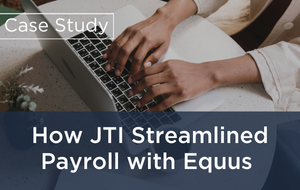HR needs to shift their technology thinking and priorities and focus on purpose-built solutions to manage dispersed workforces.
By Cathy Koslowski, Equus Software
Sourcing talent has gone global. Businesses can hire developers from Brazil or Dubai, and workers that used to live near a Chicago headquarters have been inspired to move to California or work for a month from Paris. While these moves offer benefits for employees and give employers access to a wide range of talent, it does increase the complexities of managing people.
Despite this movement, companies often lack visibility into an employee’s location, which carries with it potential liability and tax risks. According to a late 2021 report from Deloitte titled “How will remote work shape the future of global mobility?” when companies were asked if they have technology tools to track employee locations, 62 percent responded “No and currently there are no plans to implement such a technology tool.”
Changing Priorities
Instead of spending directed towards offices, businesses are allocating resources to improve the remote workers’ capabilities, through new computers, more bandwidth, home office allocations, and other duty of care measures. A core part of this spending
should also include technology for global workforce management. To handle these new dynamics, firms need technology to provide tracking of and oversight over their remote workforce without losing the personalized touches that keep employees engaged with their jobs. HR needs to shift their technology thinking and priorities and focus on purpose-built solutions to manage dispersed workforces. Unfortunately, many HR leaders operate with limited knowledge about their remote workers, whether they are facing any issues, or if there are looming compliance problems. Adopting a mobility solution that addresses the modern workforce provides HR and business leaders with a way to boost employee engagement and retention while protecting the business.
A recent survey found that 62 percent of companies have no technology tools to track employee locations even while 45 percent of employees work remotely at least part-time.
Tactical Versus Consultative Tasks
Global workforce management tools can help companies by automating many of the administrative tasks involved with managing dispersed teams and remote work. The leading solutions from companies like Equus Software help a company’s HR team automate logic-based and sequential decisions allowing the HR or Mobility teams more time for consultative or complicated cases. HR and mobility teams should also consider their company’s culture to set a proper balance between over-adopting technology vs. human interactions with their employees.
Thankfully, firms can find the proper balance by picking the right platforms that automate routine and repeated tasks. These tasks require accuracy and expediency and might include limiting approvals to countries where a legal entity already exists, limiting the duration of the request, or requiring the employee
to already have verified right to work if the request is in a different country. For example, if the employee is planning on working remotely from the south of France, there are tax, immigration and other considerations to ensure the employee is working legally and not creating undue corporate tax risk for the company.
This automation can lower the risks of HR staff approving inappropriate requests, which may impact their company’s exposure to fines or other penalties. Instead of handling routine tasks, HR and mobility groups can instead focus on offering consultations for remote workers with more complex cases or on other consultative activities.
Leveraging Tech-Produced Data
The best workforce management platforms turn data into actionable insights. They enable users to create dashboards to see individual and aggregate data, to view country-specific compensation, or to manage days out of their home location for staff members. Companies can use APIs to move mobility data into other programs for deeper analyses or to combine the data with payroll or other systems. Armed with information and context, mobility professionals have answers to their workers’ questions. Country-specific rules and tax obligations are diverse globally and ever-changing. Global Mobility teams can leverage technology to answer these questions while focusing on understanding the challenges workers face. This builds empathy and connection, so HR can operate as allies to the remote workers instead of paperwork-driven adversaries.
Technology also gives HR and mobility professionals data evidence they can use with their executives and with regulatory bodies. The data can backup what they have indicated about costs, timing of worker requests, and other important points. It provides them with a layer of protection and assuredness that reduces any worker anxieties and reassures managers and owners of zero or very low regulatory exposure. Mobility touches many areas of the business, from recruiting and retention to serving as an entryway into new markets as employees expand where they work.
Data from mobility programs can provide insights beyond HR, for example giving marketing teams data about global trends or shaping IT’s potential needs for provisioning services in new areas. Companies can only leverage these insights if they have the technology to help them. They need to understand where their workers reside and how they move around the world, so they can best meet their needs and provide the company with a clear view of their increasingly global operation.





